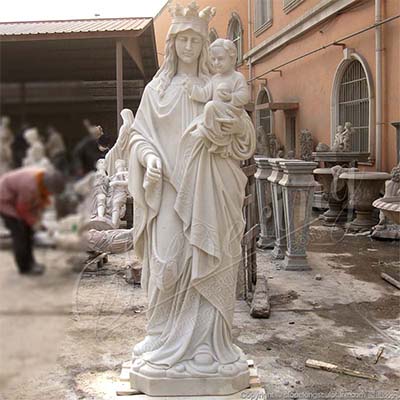White Marble Religious Statue of Jesus Christ with Open Arms for Garden or Church for sale
Exquisite white marble religious statue of Jesus Christ with open arms, symbolizing divine love, peace and acceptance. This hand carved sculpture captures the grace and compassion of Christ, making it a perfect addition to churches, homes, gardens or spiritual spaces.
Size: Life Size or Customized Size
Material: Solid White Marble
Usage: Outdoor or Indoor Decoration
Advantage: Wholesale price offered
Standing as a powerful symbol of faith, this religious statue features Jesus Christ with open arms, inviting all who behold it to experience the grace and mercy of the Savior. Whether placed in a church, home, garden or religious sanctuary, this religious statue serves as profound representation of Christian devotion and spirituality.

With his arms spread wide in an embrace that symbolizes openness, acceptance, love and compassion, the Jesus statue welcomes all who approach with a spirit of understanding and forgiveness, offering unconditional love, protection and salvation. Jesus' face is serene and peaceful, with lowered gaze, representing Christ's deep empathy for humanity's struggles. This religious statue serves not only as a beautiful decorative piece but also as a constant reminder of Christ's love and sacrifice. It would be a treasured gift for baptisms, confirmations, or any milestone in the Christian faith.
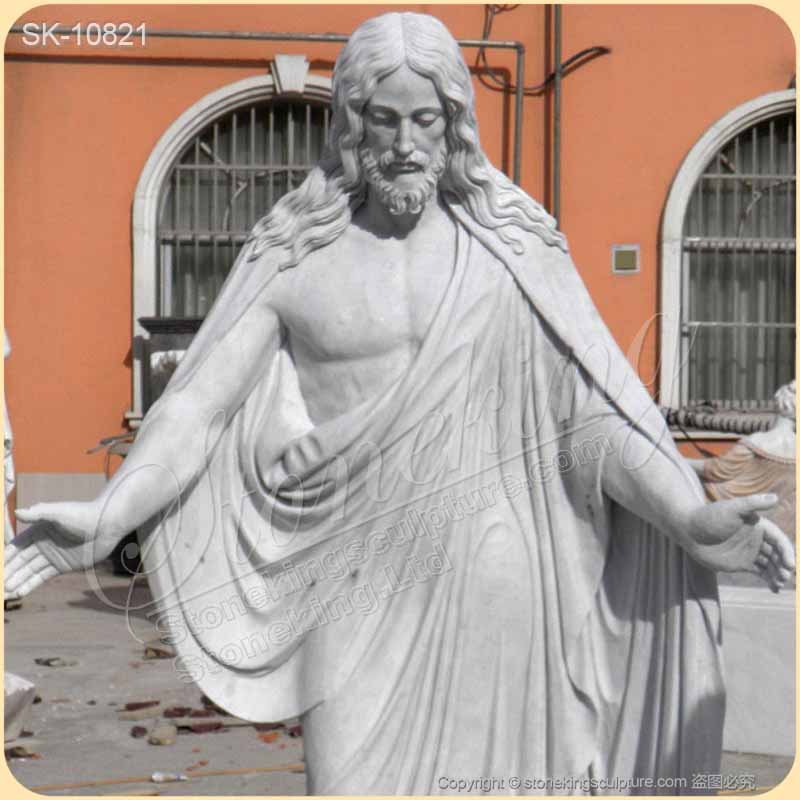
Hand carved from premium white marble, this Jesus Christ statue is built to last for generations. Whether displayed indoors or outdoors, the marble's natural resistance to weather to and wear makes it a versatile addition to gardens, patios or outdoor shrines, allowing you to experience the grace of Jesus in nature's embrace.

Table of Contents
What are the Different Types of Marble Religious Statues?
Why are Religious Statues Important in Various Religions?
What are the Historical Origins of Marble Religious Statues?
What are the Benefits of Marble for Religious Statues?
How Much do Marble Religious Statues Cost?
Can Marble Religious Statues be Customizable?
What is Significance of Marble in Religious Statues?
How to Clean and Maintain a Marble Religious Statue?
Where are Marble Religious Statues Commonly Placed?
Are Marble Religious Statues Suitable for Outdoor Use?
What is the History of Marble Religious Statues in Religious Art?
Why are Marble Statues Used in Religious Settings?
How Long do Marble Religious Statues Last?
What is a Religious Statue?
A religious statue is a sculptural representation of a figure or symbol associated with a specific faith, serving as a visual and often sacred embodiment of spiritual beliefs. These religious statues are often crafted in various materials, including stone, wood, metal, bronze, clay or even modern materials like resin, and are created to honor deities, saints, prophets, or other significant figures central to religious practices. Their forms, purposes and styles vary widely depending on the cultural and spiritual traditions they represent.

Marble is prized for its durability, natural beauty and the timeless elegance it lends to artistic creations, making it a popular choice for religious statues. Marble's workability enables artisans to create intricate designs and realistic textures, making the marble religious statues a treasured addition to any sacred or serene space.
Religious statues often serve as focal points for prayers, meditation or rituals. They are venerated in churches, public places, cathedrals, gardens and homes as reminders of faith and inspiration for devotion. In Christianity, religious statues serve as tangible expressions of faith, devotion and teaching tools to communicate the principles and stories of the Bible. They represent key figures such as Jesus Christ, the Virgin Mary, saints and angels, as well as biblical events like the crucifixion or nativity.
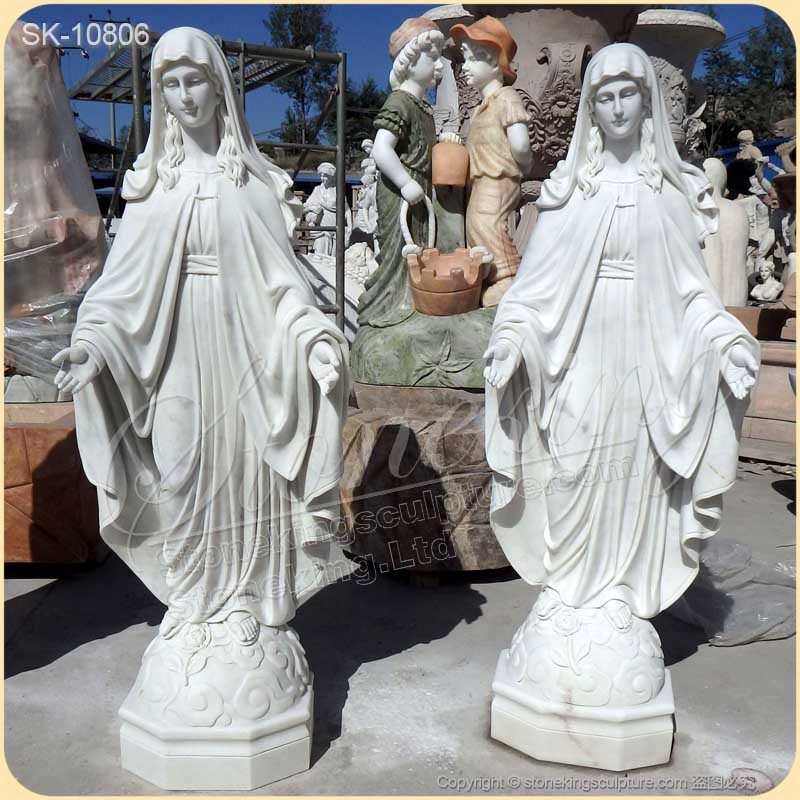
The religious statues help individuals feel closer to God to seek intercession from saints. These figures inspire people to emulate their faith, compassion or courage in their daily lives. Angels, symbolize protection, guidance and God's presence. In historical contexts, these statues were used to convey Biblical stories and Christian values to those who could not read, and today, they continue to serve a visual aids to teach and remind believers of the faith's principles. Furthermore, these statues often symbolize the identity of a church or Christian community, uniting members through shared veneration of a particular saint or devotion.
Religious statues bridge the gap between the physical and spiritual realms, offering a tangible connection to the dive. Rich in history, symbolism and artistry, they continue to play a vital role in Christian worship and culture, inspiring believers to deepen their faith and live by Christ's teachings.
What are the Different Types of Marble Religious Statues?
Jesus Christ Statues
Marble statues of Jesus Christ are among the most prominent in Christian art. They depict various moments of His life and sacrifice, emphasizing different aspects of His divinity and teachings. There are the Crucifixion Statues that represent Jesus on the cross, symbolizing His Sacrifice for humanity's sins; the Christian Jesus statue of Sacred Heart of Jesus which focuses on His compassionate love and mercy, often showing His heart surrounded by flames and a crown of thorns; Resurrected Christ that captures Jesus after His resurrection with a serene expression, symbolizing hope and eternal life; Good shepherd that shows Jesus caring for a lamb, highlighting His role as a protector and guide.

Virgin Mary Statues
The Virgin Mary is a central figure in Christian devotion, and marble statues often emphasize her face, purity and maternal love. The Our Lady statue or Our Lady of Grace depicts Mary with open arms, symbolizing her intercession and blessings. The classic Pieta sculpture depicts a sorrowful Mary cradling the body of the crucified Christ, often evoking deep emotional and spiritual reflection. The Immaculate Conception portrays Mary as a young woman standing on a crescent moon, emphasizing her sinless nature. The Madonna and Child is a tender portrayal of Mary holding the infant Jesus, symbolizing her role as the Mother of God. Our Lady of Lourdes sculpture portrays Mary as she appeared to St. Bernadette, often used in grottoes and outdoor shrines.

Saints Statues
Marble statue of stains are created to honor their lives of holiness and dedication to God. They are often designed with attributes that represent their stories or martyrdom. St. Peter patron Statue is often depicted holding the keys heaven, and St. Paul is often with a sword. Sacred St. Joseph is often depicted holding a lily (symbol of purity) or carpenter's tools. St. Michael the Archangel is commonly shown as a warrior with a sword defeating Satan, symbolizing protection and triumph over evil. St. Francis of Assisi is frequently depicted with animals, reflecting his role as the patron saint of nature. St. Teresa of Avila or St Therese of Lisieux is represented with symbols of their spiritual devotion, such as books or roses.

Angels and Cherub Statues
Angels are considered messengers of God and guardians of humanity. Marble angel statues are common in churches, cemeteries and private gardens. The Guardian Angels are often depicted protecting children or families, symbolizing protection and guidance. Archangels like Gabriel, Raphael and Michael are popular, symbolizing divine guidance and protection. Cherubs are smaller angelic figures with a youthful appearance, symbolizing innocence and divine presence. Praying angels are often depicted hands clasped in prayer, conveying piety and devotion. Trumpeting angels hold a trumpet, often symbolizing the announcement of divine events or the final judgement.
Nativity Scenes
Marble Nativity statues depicts the birth of Jesus Christ. These sets include the Holy Family, shepherds and animals, The Three Wise Men, the angel announcing Jesus's birth, emphasizing the humility and divinity of Christ's birth.
Crosses and Crucifixes
While not statues in the traditional sense, marble crosses and crucifixes are central to Christian symbolism. They are often standalone pieces in churches or as monuments.
Custom and Thematic Designs
Many Christian marble statues are custom-made to represent specific themes, events or visions, such as The Last Supper which is carvings of Jesus and his disciples during the final meal, The Holy Trinity that represents the Father, Son and Holy Spirit in harmony.
Why are Religious Statues Important in Various Religions?
Religious statues hold significant meaning across various world regions, often serving as symbolic representations of divine beings, revered figures, or sacred principles. Christian religious statues have remained a central feature in Catholic, Orthodox, and some Anglican traditions, serving as powerful symbols of faith, devotion and the connection between the divine and the earthy realm. These statues are not mere artistic representations but serve multifaced roles in worship, education and spiritual reflection.
Representation of the Divine
In many religious traditions, statues function as physical representations of divine or holy figures These images make abstract concepts of spirituality more accessible to human understanding. In Christianity, statues primarily serve to represent important figures in the faith, such as Jesus Christ, the Virgin Mary, the apostles, saints and angels. These figures are seen as embodying divine virtues and holiness, and statues help believers focus their thoughts and prayers. For examples, Religious Christ sculpture often represents sacrifice, redemption and the centrality of Christ's role in Christian salvation, while religious Mary statue may symbolize maternal love, compassion and intercession. The saint statues, such as the Evangelist Matthew statue and the Apostle Paul statue may represent different facets of the Christian life, such as courage, charity or spiritual wisdom.

Focal Points for Worship and Devotion
For many Christians, statues act as focal points during prayer and worship. The physical presence of a religious statue can create a sacred space, inviting worshippers to meditate, reflect and offer prayers. Statues may be placed in churches, homes or chapels as reminders of the faith, helping individuals to feel a closer connection to the figures they represent. For example, Catholics might turn to a statue of Our Lady of Lourdes, Virgin of Guadalupe statue, or St. Therese of Lisieux for specific intercessions, believing that these saints, who lived exemplary Christian lives, can advocate on their behalf before God.
Educational Role
Religious statues can also serve as educational tools, helping individuals understand and internalize religious teachings. In earlier periods of history, many people could not read or access the Bible in their native language. Statues, paintings, and other visual art forms served as important tools for communicating biblical stories, Christian teachings and moral lessons. In Christian, statues or images of Jesus' life teach key theological points about sacrifice, resurrection and salvation. For many centuries, Christian statues and paintings were the primary way for illiterate people to learn about the biblical narrative. These figures acted as "living sermons" that conveyed the gospel message in ways that transcended language or education levels. This educational role extends beyond churches and homes, influencing religious practice an belief in broader cultural contexts.

Aesthetic and Cultural Expression
Religious statues also play an important role in preserving cultural and historical traditions. In many cultures, the creation of religious statues is a form of artistic expression that reflects the values and aesthetics of the time. For example, the grand statues of the Greek gods and the Roman gods in ancient temples were not only objects of worship but also representation of the cultural ideals of beauty, strength and virtue. Throughout history, artists have used sculptures as a way to express the beauty of the divine, producing masterpieces that evoke awe and worder. Such as, Michelangelo's Pieta or the numerous statues of the Madonna found in churches worldwide are only acts of religious devotion but also expressions of the profound beauty and mystery of the Christian faith.
These works of art often inspire a sense of reverence and admiration for the sacred, and they contribute to the cultural heritage of Christianity by preserving the faith's history, values and theological concepts.
Veneration and Spiritual Connection
In Catholic and Orthodox traditions, religious statues are not only simply ornamental but are venerated as representations of holy people. This veneration involves showing respect, reverence and honor to the person depicted. The act of praying in front of a statue is understood to be a way of connecting spiritually with the saint or figure represented, not as a form of idol worship but as a means of asking for divine intercession. The practice of venerating these statues helps to solidify a collective identity, linking individuals not only to their local community but also to the broader history of Christianity.
What are the Historical Origins of Marble Religious Statues?
Marble religious statues have a rich history rooted in ancient art and culture, spanning several millennia. The use of marble as a medium for religious sculpture can be traced back to the classical world, particularly in ancient Greece and Rome, and evolved over centuries through various cultural and religious movements.
Ancient Greece and Rome
The origins of marble religious statues can be traced to the classical art traditions of ancient Greece, where marble was prized for its purity, fine grain and ability to capture fine details. The ancient Greeks used marble to create statues of gods, goddesses and mythological figures, which were often placed in temples or public spaces as representations of divine power. The most iconic example from this period is the Parthenon Marbles, a series of sculptures that depict various gods, heroes and mythological scenes. With the rise of the Roman Empire, Greek traditions in sculpture were adopted and further developed. The Romans also began producing portrait statues of their emperors, which were often placed in temples or other religious sites. These statues were often seen as a symbols of divine authority or divine right, blurring the lines between politics and religion.
Early Christian Era
As Christianity began to spread across the Roman Empire in the 1st century CE, religious imagery started to evolve. Early Christian art was initially characterized by symbolic representations rather than realistic depictions, as early Christians sought to avoid the pagan traditions of idol worship. However, as Christianity became more established and accepted, marble statues began to be used to represent biblical figures, saints and the holy family. These statues were not intended to be lifelike portrayals but were more symbolic, emphasizing spiritual transcendence rather than human realism.

The Renaissance Revival
The use of marble for religious statues saw a major revival during the Renaissance in the 14th to 17th centuries. This period marked a renewed interest in classical antiquity and its artistic achievements. Italian sculptors, including Donatello, Michelangelo and Gian Lorenzo Bernini, looked to the classical tradition for inspiration while infusing their works with Christian iconography.
Michelangelo's famous sculptures, like the Pieta and David, are celebrated as masterpieces of religious art. The Renaissance revival of marble for religious sculptures helped to shift the portrayal of sacred figures form the stylized, flat images to more humanized, emotional representations. These works were created not only for the glory of God but also to inspire personal devotion and connection to the divine.
Baroque and Beyond
During the Baroque period, marble religious statues became more expressive, with an emphasis on dramatic poses and intense emotion. Statues were designed to provoke awe, faith and emotional engagement. During the 18th and 19th centuries, marble religious statues were commissioned by churches, cathedrals and private patrons across Europe and the Americans. Statues of saints, the Madonna and Christ were commonly found in public an private spaces, acting as a focal points for devotion. The influence of Romanticism and Neoclassicism during these periods ensured that marble remained a prominent medium for religious art, even as the artistic landscape shifted.
What are the Benefits of Marble for Religious Statues?
Marble has been a favored material for religious statues for centuries due to its unique combination of physical, aesthetic and symbolic qualities. Religious statues, including depictions of deities, saints and sacred symbols, often require materials that convey a sense of timelessness, purity and reverence. Marble fulfills these requirements exceptionally well.
Durability and Longevity
Marble is renowned for its durability, making it an excellent material for statues meant to endure for generations. Properly maintained marble religious statues can last centuries, making it ideal for religious use where longevity is essential. Religious statues, often placed in public spaces, homes or temples, are subject to natural wear and tear from environmental factors like sunlight, rain and temperature fluctuations. Marble's resistance to erosion and weathering ensure that these statues retain their integrity and beauty for centuries. This durability makes it an excellent material for preserving religious symbolism and heritage.

Symbolism of Purity and Divinity
Marble's association with purity, permanence and spirituality aligns well with religious themes. White marble, in particular, is often chosen for its connotation of purity and divinity, enhancing the spiritual aura of the statue and making it a popular choice for statues of gods, saints and other revered figures.
The material's translucency under light can evoke a sense of life and vitality in statues, enhancing their spiritual presence. This symbolic resonance makes marble a natural choice for creating sacred art that inspires devotion and reverence.
Aesthetic Appeal
Marble's natural elegance, with its fine grain and smooth texture allow for intricate carving, enabling artists to create detailed and lifelike depictions of deities and religious figures, such as facial expressions, drapery folds and symbolic motifs with precision. Additionally, the natural veining in marble provides a unique visual appeal, making each statue one-of-a-kind. The polished finish of marble also enhances its visual impact, giving the statue a refined and majestic look.
Cultural and Historical Significance
Marble has been used in religious art and architecture since ancient times, from Greek and Roman temples to Renaissance churches and Buddhist shrines. This historical association lends marble religious statues a sense of authenticity and tradition. In many cultures the use of marble is seen as a sign of devotion and respect for the divine.
Ease of Maintenance
Although marble requires some care to prevent staining or etching, it is generally easy to maintain compared to other materials like wood or clay. Regular cleaning and occasional polishing can keep a marble religious statue looking pristine for decades, preserving its spiritual and artistic value. This makes it practical for use in places of worship or public spaces.
Heat Resistance and Weather Adaptability
Marble is resistance to extreme temperatures, making it suitable for both indoor an outdoor use. This adaptability is crucial for religious statues placed in temples, garden, religious settings, or open-air sanctuaries.
Prestige and Value
Marble has been an inherent sense of luxury and prestige, making it a favored material for sacred and ceremonial purposes. Marble religious statues hold a timeless appeal that resonates across cultures and generations. Many iconic religious sculptures were crafted from marble, symbolizing a divine connection, and marble religious statues often reflect cultural heritage, representing the unique artistic styles and spiritual beliefs of specific regions. For many, the presence of a marble statue in a home, temple or garden reflects both religious dedication and an appreciation for art. In addition to spiritual significance, these statues are displayed as symbol of wealth, sophistication and refined taste. As embodiments of faith and artistry, they stand as timeless treasures that inspire reverence and admiration, making them an esteemed addition to any sacred or personal space.
How Much do Marble Religious Statues Cost?
The cost of marble religious statues varies widely based on several factors, including the size, design complexity, quality of the marble and the craftsmanship. Generally, a small, basic design religious statue may cost about USD1500 to USD2500, while a larger and intricate designed pieces may cost over USD3000.
The quality of marble used is one of the primary factors that impact the cost of the statue. For premium marbles, some rare marbles or imported marbles, they are more costly. In contrast, locally sourced or less rare types of marble are less expensive. The region where the marble is sourced from can also affect cost, with transportation costs adding to the overall price. High quality marble is free from cracks, impurities or other imperfections, so religious statues carved from such high-grade marble will command higher prices due to their aesthetic value and durability.

The size of the religious statue is one of the most straightforward factors affecting its cost. Larger religious statues require more raw material, labor and to carve, which naturally increases the cost. For small statues, they are generally less expensive, but intricate details can still drive up the cost. For medium and large religious statues, which may require extensive carving and finishing work, can be quite costly. And for very large and monumental religious statues, such as those used in cathedrals or public spaces, can be more expensive due to both the size and the complexity of the work.
The complexity of the design is another critical factor that influences the price. Statues with simple design and minimal detailing are generally less expensive, while more intricate, finely detailed carvings will cost more. Religious statues often feature fine details like clothing, facial expressions, hand gestures and symbolic elements. The more detailed the carving, the more labor-intensive and expensive the work becomes. Custom designs tailored to specific religious beliefs, rituals or symbolism will require more time, skill and attention to details. Adding unique details, such as inscriptions, custom postures, or symbolic ornaments, increases the time and effort involved.
When purchasing a marble religious statue, buyers should consider all the aspects to understand the value and make informed decisions based on their needs and budget.
Can Marble Religious Statues be Customizable?
Marble religious statues can be highly customizable, both in terms of design and features, making them a popular choice for those seeking a personalized piece for spiritual preferences, as well as aesthetic desires. Customization options for marble religious statues typically range from modifying the size, design and details to including personalized inscriptions or choose specific types of marble.
Marble religious statues, whether representing deities, saints or other spiritual figures, can be designed to reflect specific attributes or styles. Customization allows for changes in the pose, facial expression, clothing and accessories. The statue's size can be customized according to the space in which it will be displayed. Whether it is a small, delicate piece meant for a personal altar or a grand sculpture for a church or garden, marble religious statues could be made according to your requirements.
The type of marble chosen for the statue can have a significant impact on its appearance and durability. Different types of marble, ranging in color from pure white to subtle shades of green, gray or beige, can be selected to create a unique visual effect. Personalized text, such as religious verses, names, dates or prayers, can be engraved onto the base of the statue or on the statue itself, providing a personal touch and deepen the spiritual connection. Crosses, symbols or patterns could also be carved to enhance its spiritual significance.
Marble statues can be polished to different levels of sheen, from a matte finish to a high gloss. A glossy finish enhances the marble's natural luster, while a matte finish can offer a more subtle, aged appearance. The customization of a marble religious statue goes beyond just the physical appearance, it should resonate with the deeper spiritual meaning you wish to convey. Whether you are seeking a highly detailed depiction of a deity, an iconic religious figure or a more symbolic representation, custom marble religious statues can provide a meaningful and lasting presence in your spiritual or religious practice.
What is Significance of Marble in Religious Statues?
Marble has long been associated with religious and spiritual imagery, serving as a medium for religious statues in various cultures around the world. Its significance lies not only in its aesthetic qualities but also in its symbolic associations with purity, permanence and divine beauty. The use of marble in religious statues has transcended time and culture, making it a powerful material in the creation of sacred art.
Aesthetic and Physical Quality of Marble
Marble is celebrated for its durability, workability and unique aesthetic qualities. Marble's physical characteristics are central to its appeal as a medium for religious sculptures. It is metamorphic rock that is formed under high pressure and heat, which gives it a smooth texture and lustrous sheen. Marble's softness relative to other stones also allows for intricate carvings, allowing artists to create lifelike details in the faces and bodies of statues. Marble's durability is another key in its use for religious statues. Unlike other materials, such as wood or clay, which are more prone to wear and decay, marble is highly resistant to the elements and can endure for millennia. This longevity makes marble an ideal medium for creating sacred objects that are intended to last beyond the lifetimes of their creators and worshippers. For this reason, marble religious statues have been placed in temples, churches and sacred spaces, where they can serve as enduring symbols of divine presence and protection.

Symbolism of Purity and Perfection
In various religious traditions, marble holds symbolic meaning due to its purity, strength and timeless qualities. The pure white color of marble is often associated with holiness, eternity, immortality and spiritual transcendence. In Christian art, for examples, marble statues of saints, angels and Christ are symbolic of divine purity. The smoothness of the stone can represent the removal of imperfections, suggesting the transcendence of the soul or the divine nature of the figure depicted. The very nature of the marble-unblemished, eternal and solid- mirrors the qualities of the divine, making it a fitting choice for representations of deities.
Historical Use in Religious Contexts
Throughout history, marble has been the material of choice for some of the world's most significant religious statues and sculptures. In ancient Greece, marble was used to create some of the most iconic sculptures of Gods and Goddesses. In the Christian tradition, marble has been employed in the creation of grand altarpieces and statues of saints and biblical figures.
The Timelessness of Marble
One of the most profound aspects of marble as a material for religious statues is its durability. Marble, when properly maintained, can last for centuries without losing its beauty or structural integrity. This longevity ensures the permanence of the statues, which aligns with the enteral nature of religious truths and deities. In many religious contexts, statues and sculptures serve as focal points for worship and meditation, and their ability to withstand the passage of time is seen as a reflection of the enduring nature of the divine.
How to Clean and Maintain a Marble Religious Statue?
For regular cleaning of a marble religious statue, the needed materials are: soft microfiber or cotton cloths, a soft-bristled brush, mild soap or pH-neutral detergent and distilled water. Begin by gently dusting the statue with a soft cloth to remove surface dust and debris, and avoid abrasive materials that could scratch the surface. Then dampen the cloth with distilled water ( avoiding tap water to prevent mineral residue) and gently wipe the surface. Next to rinse the statue by using a sperate cloth dampened with clean distilled water to remove any soap residue, and dry the statue thoroughly. Pat the surface dry with a clean, dry cloth to prevent water spots.
For stubborn dirt, mix a few drops of mild, pH-neutral soap with distilled water. Dip a soft cloth or brush into the solution and clean the statue carefully, paying special attention to intricate details. For some light stains, please mix a paste of baking soda and water, apply it to the stain, and leave it for a few hours, then gently wipe off with damp cloth and dry thoroughly. For some deeper stains, apply a poultice past made of baking soda ana distilled water directly to the stained area. Cover it with plastic wrap and let it sit for 24-48 hours, then remove the past and rinse with water, and dry it thoroughly. Never use acidic cleaners, vinegar or harsh chemicals as they can damage the marble.
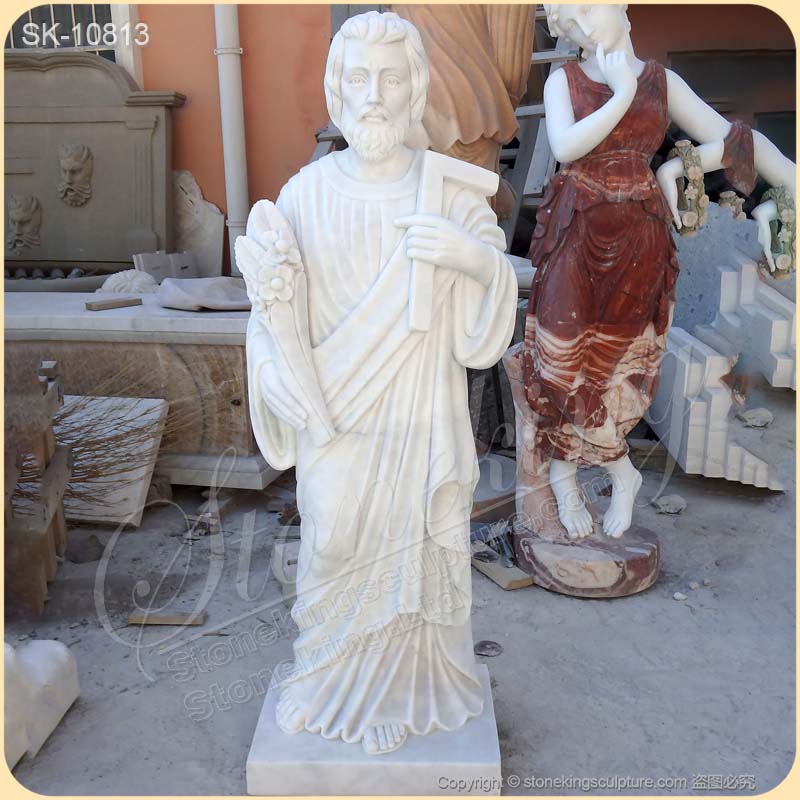
As prolonged exposure to sunlight can discolor marble, it is better to place the statue in a shaded or indirect light area. Ensure the area around the statue is dry and free from excessive humidity to prevent mold or mildew growth. Regular inspect for any cracks, chips or discoloration and address these issues promptly. When moving or cleaning, handle the statue carefully to avoid damage.
Ensure the statue is placed on a stable, level surface to prevent tipping or damage. For regular maintenance, please keep the statue free of dust by wiping it down with a soft, dry cloth regularly, and perform a deeper clean every few moths to remove accumulated grime. Proper care not only maintains the physical appearance of the marble religious statue but also honors its spiritual essence, ensuring it remains a source of inspiration and peace for generations to come.
Where are Marble Religious Statues Commonly Placed?
Churches and Cathedrals
Marble religious statues are frequently placed within the sanctuaries of churches and cathedrals. They are often located near altars, prayer areas or within niches in the walls. These placements inspire devotion and help focus prayer and worship. The religious sculptures can also adorn the exterior of the churches, often as part of architectural features like facades, entrances or bell towners. These statues act as a welcoming gesture to parishioners and passerby, symbolizing the church's role as a beacon of faith.
Homes and Private Chapels
Marble religious statues are often installed in private homes for personal devotion and reflection. Many individuals place them in gardens or courtyards to create serene, spiritual environments. These statues serve as daily reminders of faith and help foster a spiritual atmosphere in the home. Statues of the Virgin Mary or the Holy Family are placed on home altars or shelves for daily devotion. Outdoor statues Mary or of St. Francis are common in gardens, creating peaceful spiritual environments.
Public and Communal Spaces
Large-than-life marble religious statues are frequently installed in public spaces to symbolize communal faith or as landmarks of cultural heritage. These often commemorate historical figures or events tied to Christian faith and culture. Massive marble statues, such as Christ the Redeemer in Brazil, attract devotees and tourists alike. In some cultures, marble statues of religious leaders or saints are erected in public squares to commemorate their influence or as part of historical monuments.
Cemeteries and Memorial Gardens
Marble religious statues are commonly placed in Christian cemeteries to honor the deceased and provide a spiritual atmosphere. These statues often depict angels, Christ or the Virgin Mary, symbolizing protection resurrection and intercession. Figures like angels, crosses or representations of saints and deities are frequently chosen for their symbolism of protection and eternal peace. Large statues in central locations, such as a statue of Jesus with outstretched arms, offer comfort and hope to visitors.
Educational and Cultural Institutions
Marble religious sculptures are often displayed in museums or heritage sites to educate visitors about historical and cultural traditions. In institutions with a religious affiliation, marble religious statues are sometimes placed in courtyards or prayer halls to inspire reverence and learning. Statues of patron saints or biblical figures are placed in courtyards, libraries or chapels to inspire and educate students and visitors.
Are Marble Religious Statues Suitable for Outdoor Use?
Marble religious statues are a popular choice for outdoor use, prized for their natural beauty, timeless appeal and association with elegance and reverence. Marble is a metamorphic rock composed primarily of calcite, which gives it a smooth texture and natural veining. It is durable and resistant to wear and tear, making it a viable choice for outdoor environments. Marble's natural beauty enhances religious spaces, making it a fitting material for sacred sculptures.
Marble's natural veining and smooth finish lead a sense of divinity and purity to religious statues, making them ideal for temples, churches, gardens and memorial spaces. Marble can withstand a variety of weather conditions, including heat, cold, moderate rain, sunlight and temperature variations, especially when properly sealed and maintained.

Acid rain and pollution can erode its surface, dulling its appearance and causing pitting over time. Freeze-thaw cycles in colder climates can lead to cracking or spalling as water enters small cracks and expands when frozen. Prolonged exposure to sunlight can cause slight discoloration, while moisture can lead to staining or moss and algae growth. So, regular cleaning and sealing are essential to preserve the statue's integrity. Cleaning the statue with a soft cloth and pH-neutral cleaner helps prevent the accumulation of dirt, moss and algae. Using a high quality sealant can protect marble from moisture and stains. And check for cracks, chips or discoloration, addressing issues promptly to prevent further damage. Proper maintenance ensure that the marble religious statues retains its aesthetic appeal and symbolic significance for years to come.
Marble has been used for sculptures, monuments and architectural features, including outdoor settings, due to its ability to withstand the test of time. For those seeking a balance of durability and elegance, marble remains a popular and meaningful choice for outdoor religious art.
What is the History of Marble Religious Statues in Religious Art?
Marble has been a cornerstone of religious art for millennia, valued for its durability, beauty and association with permanence and sanctity. Its history as a medium for religious statues spans ancient civilizations, classical antiquity and religious traditions, playing a crucial role in the visual representation of divine figures and sacred narratives.
Origins in Ancient Civilizations
The use of marble in religious dates back to ancient civilizations like Greece and Rome. In ancient Greece, marble was widely used to depict Gods, Goddesses and mythological figures in temples. Greek sculptors pushed the boundaries of realism and divine idealism, creating statues that became iconic representations of their gods. These figures were often placed in temples, serving both as objects of worship and as embodiments of divine presence. The Romans adopted and expanded upon Greek traditions, using marble for their deities and emperors, who were often deified after death. Religious statues in marble adorned temples, public spaces and private homes, reflecting the integral role of religion in daily life.
Christian Influence in the Middle Ages
With the rise of Christianity in the Roman Empire, the use of marble in religious art evolved. Early Christian and Byzantine art featured marble for altars, sarcophagi and carvings of biblical scenes. By the middle ages, marble became integral to the construction and decoration of cathedrals, where it adorned altarpieces, baptistries, and statues of saints. The use of marble in religious art during this era symbolized the permanence and sanctity of the Christian faith. The Gothic period saw marble religious statues become more elaborate, with intricate carvings adorning churches and cathedrals.
The Renaissance: The Zenith of Marble Religious Art
The Renaissance marked a golden age for marble religious statues driven by a renewed interest in classical ideals and humanism. Artists like Michelangelo elevated marble sculpture to new heights with works such a the Pieta and David, the later symbolizing the biblical hero's divine inspiration. Churches and patrons commissioned marble sculptures to depict the Virgin Mary, Christ and other religious figures, emphasizing naturalism and emotional expression. During this period, the Catholic church became a major patron of marble religious art, commissioning statues for basilicas, cathedrals and public spaces. These works celebrated faith and emphasize the Church's power and grandeur.

Baroque and Beyond
In the Baroque era (17th-18th centuries), marble sculptures became more dynamic and theatrical, reflecting the dramatic spiritual fervor of the time. Sculptors like Gian Lorenzo Bernini created dynamic, emotionally charged religious works, such as The Ecstasy of Saint Teresa, which is a prime example, capturing a moment of divine revelation with unparalleled emotional intensity. Marble statues and carvings of deities, aiming to rekindle faith among the faithful by emphasizing the glory of God, the suffering of Christ and the intercession of saints.
Modern and Contemporary Uses
In modern times, marble remains a significant medium for religious statues, valued for its timeless appeal. Advances in quarrying and sculpting techniques have made marble more accessible, allowing for the creation of religious statues that honor diverse faith traditions around the world. Marble's enduring appeal lies in its ability to convey both the majesty and humility of the divine, making it a timeless material for sacred art.
Why are Marble Statues Used in Religious Settings?
Marble statues have been widely used in religious settings for centuries, valued for their aesthetic qualities, symbolic significance and durability. Their prominence in sacred spaces reflects a confluence of artistic, spiritual and cultural considerations.
Symbolism of Purity and Eternity
Marble is often associated with purity and eternity, making it a fitting material for religious depictions. Its smooth, luminous surface evokes a sense of divine radiance, symbolizing spiritual transcendence and the timeless nature of religious truths. In many traditions, the use of white marble signifies purity of thought, deed and intent, aligning well with spiritual values.
Durability and Longevity
Marble is a metamorphic rock known for its strength and resistance to weathering. This durability makes it an ideal medium for religious statues intended to endure for centuries. The resilience of marble allows it to be placed in temples, churches or outdoor shrines, maintaining its form and beauty over time. The lasting nature of marble is often seen as symbolic of the eternal truths and values upheld by religious statues.
Aesthetic Appeal
Marble's natural elegance and translucence give statues a lifelike quality, enhancing their visual and spiritual impact, and marble's fine grain and ability to hold intricate details make it a favored material for sculptors. Religious statues require a high level of craftsmanship to depict the divine with the appropriate reverence and majesty. Marble enables artists to carve lifelike expressions, delicate drapery and intricate ornamentation, bringing religious figures and scenes to life. This ability to create realistic and inspiring depictions elevates the spiritual experience for worshippers, drawing them closer to the divine.

Historical and Cultural Traditions
The use of marble in religious settings is deeply rooted in history. Ancient Greeks and Romans employed marble extensively for temples and sculptures dedicated to their gods. This tradition influenced late cultures, including Renaissance Europe, where marble was used for Iconic religious works such as Michelangelo's Pieta and David. This historical continuity lends marble an aura of sanctity and respect.
Cultural Identity and Prestige
In many cultures, the use of marble in religious sculptures is associated with wealth, prestige and devotion. Constructing a temple or placing a marble statue within a sacred place is often seen as an act of reverence and a demonstration of the community's dedication to their faith. Marble's association with grandeur and beauty elevates the status of religious monuments, attracting pilgrims and devotees.
How Long do Marble Religious Statues Last?
Marble is inherently durable, with some ancient marble statues and monuments surviving thousands of years. Its strength and resistance to general wear and tear make it suitable for long-term use in both indoor and outdoor settings. Marble religious statues have adorned temples, churches and sacred spaces for centuries, with many ancient examples still standing today. For instance, classical sculptures from Greece and Rome demonstrate the enduring quality of marble, provided it is well-maintained.
The longevity of a marble religious statue is heavily influenced by its environment. Statues placed indoors, such as in temples, shrines or homes, tend to last much longer than those exposed to the elements. Acid rain can lead to the marble surface erosion over time, and high levels of air pollutants can accelerate the deterioration of outdoor marble statues. Repeated cycles of freezing and thawing can cause micro-cracks, weakening the structure. Prolonged exposure to water can result in discoloration or moss and algae growth, which can further deteriorate the surface.
Regular maintenance, such as cleaning and sealing, is essential to preserve the marble's integrity. Regular dusting and gently washing with water and a soft brush helps prevent the buildup of dirt and grime. For outdoor statues, applying a protective sealant can minimize water absorption and surface staining. Acidic or abrasive cleaning agents should be avoided, as they can damage the marble's surface. For statues placed in gardens, cemeteries, or public spaces demands more attention.
Historical examples of marble statues demonstrate their incredible durability. Ancient Greek and Roman sculptures, many of which were religious in nature, have survived thousands of years despite being exposed to varying degrees of environmental stress. For instance, the Parthenon's marble sculptures, though weathered, still stand as a testament to marble's resilience. When properly cared for, marble religious statues can last for generations and even centuries, serving as testaments to artistry and spirituality.
Our option for customized Jesus Christ statue and other religious statues allows individuals to infuse their unique spirituality, devotion and artistic preferences into these sacred artworks. Different colors of marble materials could be selected for the sculpting, such as the white marble, yellow marble, black marble, red marble and other colors. Whether it's a life-size outdoor sculpture or a smaller indoor statuette, or a extra large one, the sizes could be bespoke to suit the intended space to express faith or ritualistic practices.








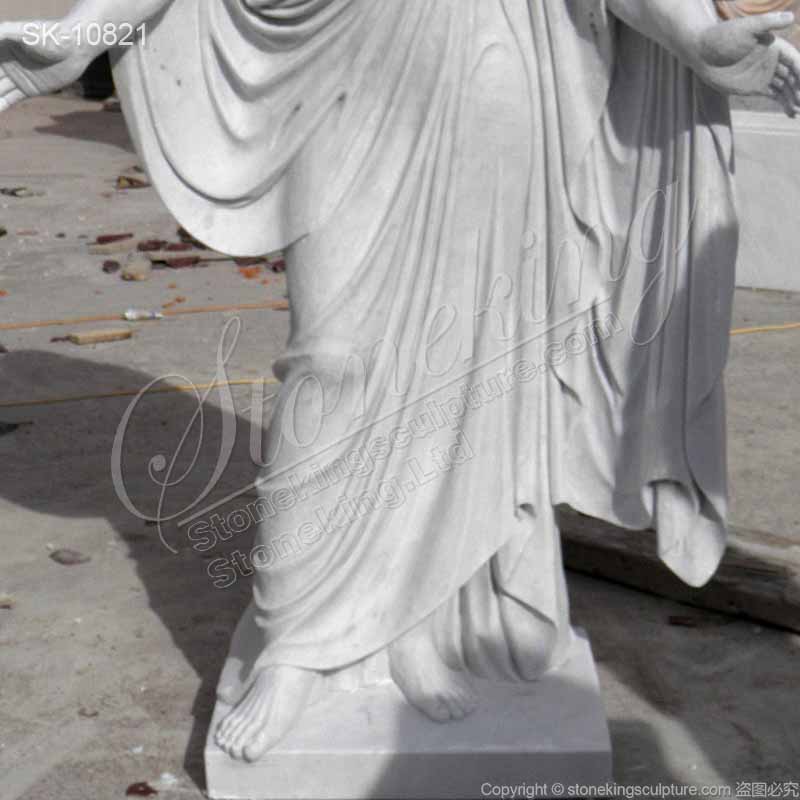
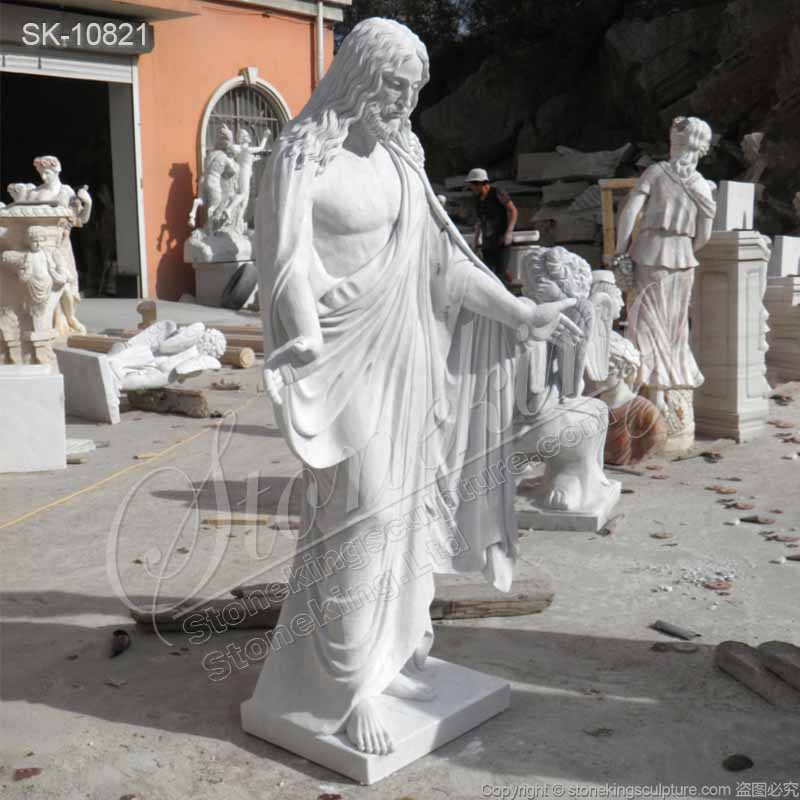
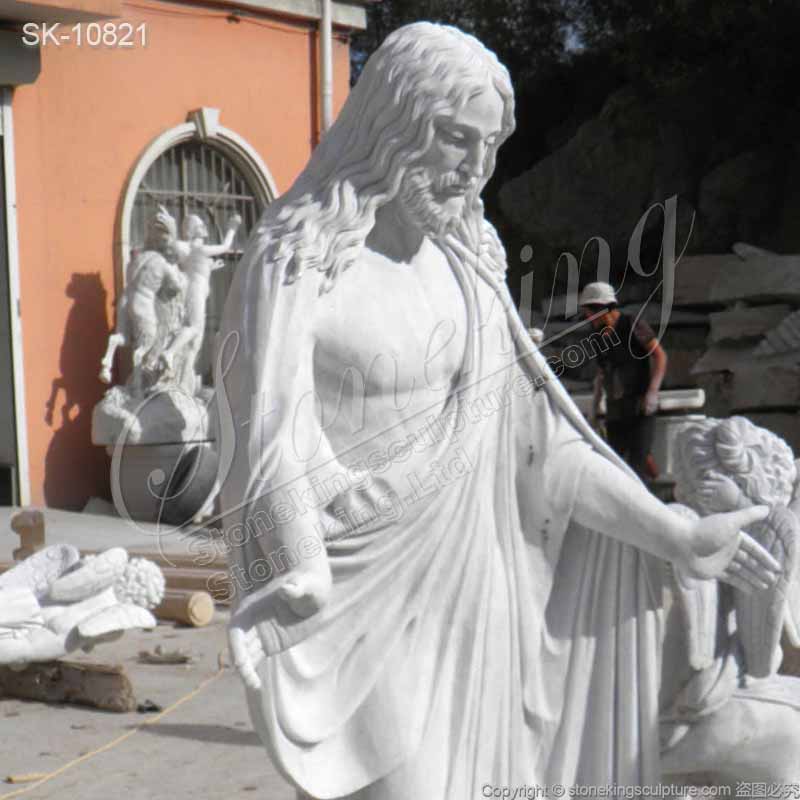
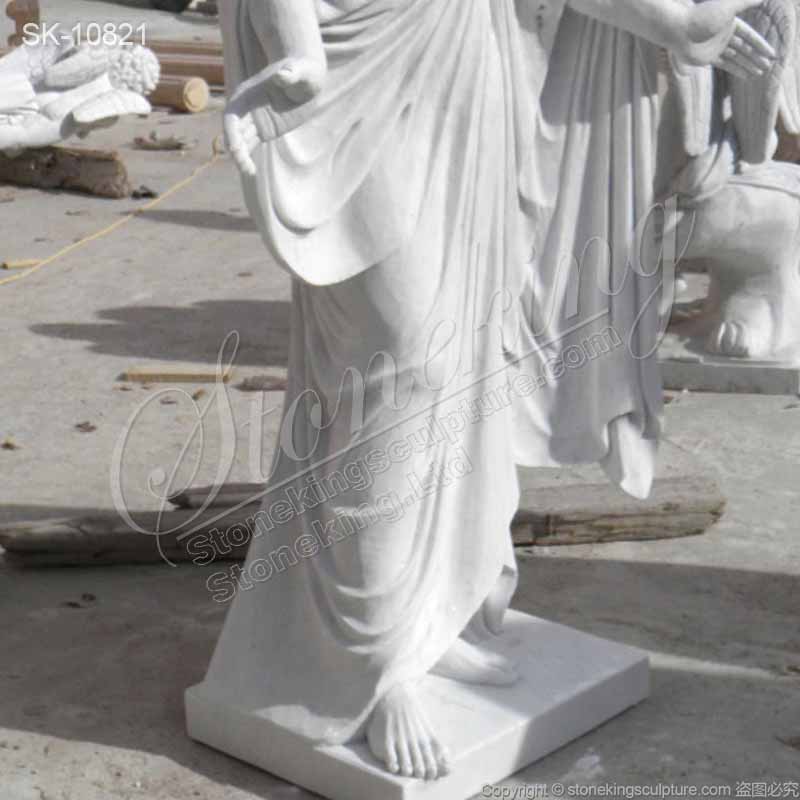
 Add to Inquiry List
Add to Inquiry List 


